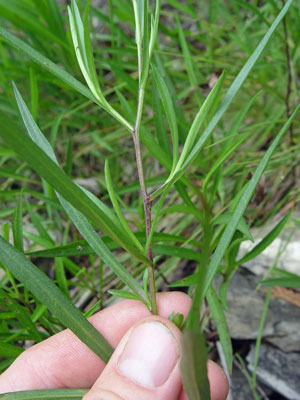DACF Home → Bureaus & Programs → Maine Natural Areas Program → Communities, Plants, and Animals → Rare Plants → Symphyotrichum anticostense

Symphyotrichum anticostense (Fern.) Nesom
Anticosti Aster
- State Rank: S1
- Global Rank: G3
- State Status: Endangered
Habitat: Circumneutral, cobble rivershores [Non-tidal rivershore (non-forested, seasonally wet)]
Range: Quebec south to Maine.
Aids to Identification: This aster is somewhat similar in appearance to the common New York aster (S. novi-belgii). Anticosti aster grows from a long, creeping rhizome, as does the New York aster. However, the former has fewer flowering heads; narrow, almost rigidly upright leaves; and phyllaries which are neither foliaceous nor outwardly spreading, as is normally the case in S. novi-belgii. The flower stalks (called peduncles) of Anticosti aster are also often longer than 3 cm, while those of the New York aster are generally shorter.
Ecological characteristics: Little is known about the ecology of this species in Maine, as there is currently only one site in the state where it is known to occur. In Quebec and New Brunswick, this species frequents circumneutral cobble or sand rivershores that are kept clear of woody competitors (e.g., Alnus spp. and Salix spp.) by period rivershore scouring by ice in the springtime.
Phenology: Perennial.
Family: Asteraceae
Synonyms: Aster anticostensis Fern.
Known Distribution in Maine: This rare plant has been documented from a total of 2 town(s) in the following county(ies): Aroostook.
Reason(s) for rarity: At southern limit of range. The 1901 collection, labeled as Aster junceus, was extirpated by the Tinker Dam on the Aroostook River, when the botanically rich gravel rivershores and ledges in Fort Fairfield were submerged.
Conservation considerations: Maintain hydrologic integrity of its rivershore habitat, including the natural disturbance by water and ice. All-terrain vehicle use of the habitat, if it were to occur, could be detrimental to the plant.